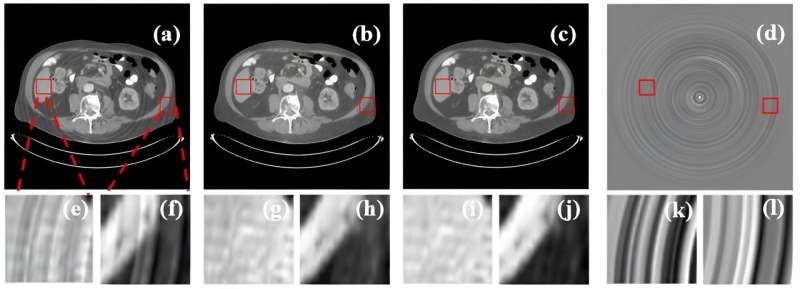This article has been reviewed according to Science X's editorial process and policies. Editors have highlighted the following attributes while ensuring the content's credibility:
fact-checked
peer-reviewed publication
trusted source
proofread
Double contrast learning helps to remove ring artifacts in computed tomography image

Computed tomography (CT) is an imaging technique that generates three-dimensional images from two-dimensional projection data. CT is widely applied in disease detection.
However, CT images often suffer from ring artifacts, which may result from hardware defects and other factors. These artifacts compromise image quality and impede diagnosis.
Researchers led by Assoc. Prof. Liang Xiaokun from the Shenzhen Institute of Advanced Technology (SIAT) of the Chinese Academy of Science (CAS), along with their collaborators, have proposed a novel ring artifact removal algorithm based on double contrast learning (DCLGAN) and an image style transformation network.
The study was published in Physics in Medicine & Biology on Oct. 4.
The proposed method involved simulating ring artifacts on real CT data to generate the uncorrected CT (uCT) data and transforming them into strip artifacts. Subsequently, the DCLGAN synthetic network was applied in the polar coordinate system to remove the strip artifacts and generate a synthetic CT (sCT).
The researchers compared the uCT and sCT images to obtain a residual image, which was then filtered to extract the strip artifacts. An inverse polar transformation was performed to obtain the ring artifacts, which were subtracted from the original CT image to produce a corrected image.
They used real CT data to validate the effectiveness of the proposed approach. Results demonstrated that the corrected CT images showed a reduction in mean absolute error by 12.36 Hounsfield units (HU), a decrease in root mean square error by 18.94 HU, an increase in peak signal-to-noise ratio by 3.53 decibels (dB), and an improvement in structural similarity index by 9.24%.
External testing on synthetic data and CBCT images of the patient's brain further demonstrated the method's effectiveness in effectively reducing ring artifacts in the CT images.
More information: Tangsheng Wang et al, Ring artifacts correction for computed tomography image using unsupervised contrastive learning, Physics in Medicine & Biology (2023). DOI: 10.1088/1361-6560/acfa60




















